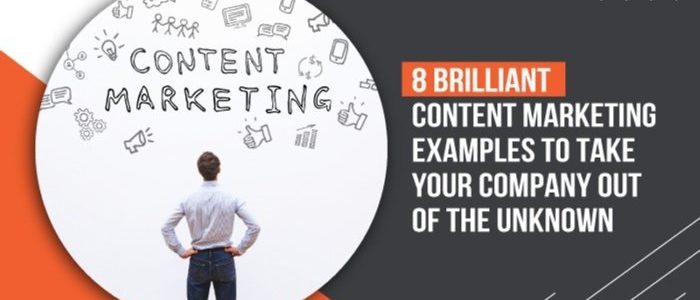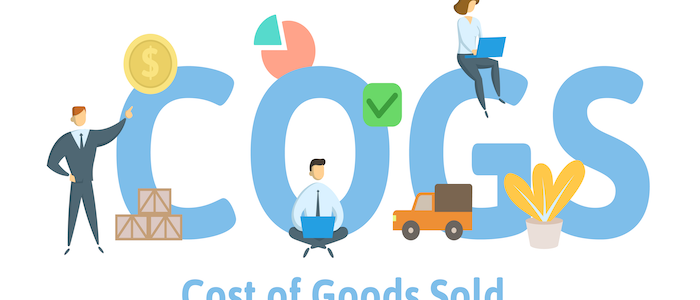TikTok’s top government relations official in Israel resigned from his position this week after pointing to the proliferation of antisemitic content on the platform. Barak Herscowitz, a TikTok vertical lead presiding over the app’s partnership with the Israeli government, shared on X Monday that he was leaving the company. Herscowitz, also a former advisor to … Continue reading Top Israeli TikTok official quits company amid accusations of antisemitism on platform
Tag: Company
DeSantis fires back at Disney as company tries to 'usurp' state oversight
Florida Gov. Ron DeSantis announced the state legislature is working on a bill to reassert its control over Disney World’s Reedy Creek Improvement District.
DeSantis said the legislature will void a development agreement Disney made to invalidate the state’s oversight of the area. DeSantis had signed a bill earlier this year, HB 9-B, that stripped Reedy Creek Improvement District of its self-governance privileges, giving oversight back to the state.
“Disney’s corporate kingdom is over — despite their repeated and futile attempts to circumvent the Legislature and the will of the people,” said Governor Ron DeSantis Monday.
DeSantis had appointed the Central Florida Tourism Oversight District Board to replace the Reedy Creek Improvement District, but the oversight board discovered the district had made development plans with Disney right before HB 9-B was enacted, giving control of the district’s development rights to Disney, Click Orlando reported.
WAR OVER THE CORPORATE KINGDOM: DESANTIS’ NEW BOARD SPARS FOR CONTROL WITH DISNEY
DeSantis said the deal was “designed to usurp the authority of the CFTOD board.”
“They [Disney] are not superior to the laws that are enacted by the state of Florida,” the governor said during a news conference Monday. “They thought they could create a development agreement that would render everything we did null and void. That’s not going to work, that’s not going to fly.”
DISNEY’S REEDY CREEK IMPROVEMENT DISTRICT TO GET NEW NAME, GOVERNOR-APPOINTED BOARD
The press conference was delivered at the Reedy Creek Administration Building. The governor added that lawmakers will end Disney’s self-inspection of rides, while allowing the state to examine an amusement ride if someone is seriously injured.
“Their cheerleaders in the media thought that Disney ‘outsmarted’ the state, but the new control board uncovered their sloppy scheme, and the agreements will be nullified by new legislation that I intend to execute. Disney will operate on a level playing field with every other business in Florida. I look forward to the additional actions that the state control board will implement in the upcoming days,” DeSantis continued.
DISNEY, NELSON PELTZ FIGHT ESCALATES IN BOARD BATTLE
“People are like, ‘Well, there’s what should we do with this land?” said DeSantis at the press conference Monday. “Maybe create a state park, maybe try to do more amusement parks? Someone even said, ‘Maybe you need another state prison?’ Who knows? I just think that the possibilities are endless.”
CLICK HERE TO GET THE FOX NEWS APP
DeSantis said lawmakers could roll out the bill by as early as next week, according to the Orlando Sun Sentinel.
The post DeSantis fires back at Disney as company tries to 'usurp' state oversight appeared first on BUSINESS DEMO WEBSITES.
The post DeSantis fires back at Disney as company tries to 'usurp' state oversight appeared first on Buy It At A Bargain – Deals And Reviews.
8 Brilliant Content Marketing Examples to Take Your Company Out of the Unknown
If you want to grow your brand, you need a content marketing plan. Why?
Seventy-eight percent of companies that produce effective content have a documented marketing strategy.
That said, there’s no use in creating content if it won’t help you achieve your marketing goals. Instead, you need to know how to recognize great content.
To help ensure your brand doesn’t fade into the background, let me walk you through eight great content marketing examples you can learn from.
What Is Content Marketing?
Content marketing is content created and shared for a specific commercial purpose, such as gaining website traffic, increasing brand awareness, or influencing people to buy your products.
A recent survey taken by professional content marketers found the following:
- 88 percent of content marketers say content marketing is effective for branding.
- 88 percent of marketers say content marketing is effective at building brand trust.
- 80 percent said content marketing works to educate audiences.
- 72 percent said content marketing is effective for lead generation.
The survey respondents said other effective uses of content marketing are driving audiences to events, building loyalty with existing customers, supporting the launch of a new product, and building subscriber lists.
“Content” has a wide definition, including podcasts, eBooks, infographics, and blog articles. Essentially, if it’s a form of media designed to acquire and influence an audience.
How do you know what makes “great” content? One of the best ways to learn content marketing is by looking at real content marketing strategy examples.
My step-by-step guide breaks down content marketing in detail.
8 Content Marketing Examples
While these content marketing examples are all unique, they have something in common: a clear purpose.
Bear that in mind as you read through these examples and you’ll better appreciate how to create successful content.
Without further ado, here’s a look at some amazing content marketing strategy examples.
1. MoonPie: Brand Voice
Content marketing is all about standing out from the crowd. One way to do this is by developing a memorable brand voice.
Why does voice matter?
According to Sprout Social’s research, 33 percent of customers say a distinct personality helps a company stand out on social media, and 46 percent appreciate brands who engage their audiences, so developing your voice is worth a shot.
MoonPie’s Twitter feed is a great example of a content marketing strategy. Not only does every Tweet have a clear purpose, but the brand uses a consistently fun tone to encourage engagement:
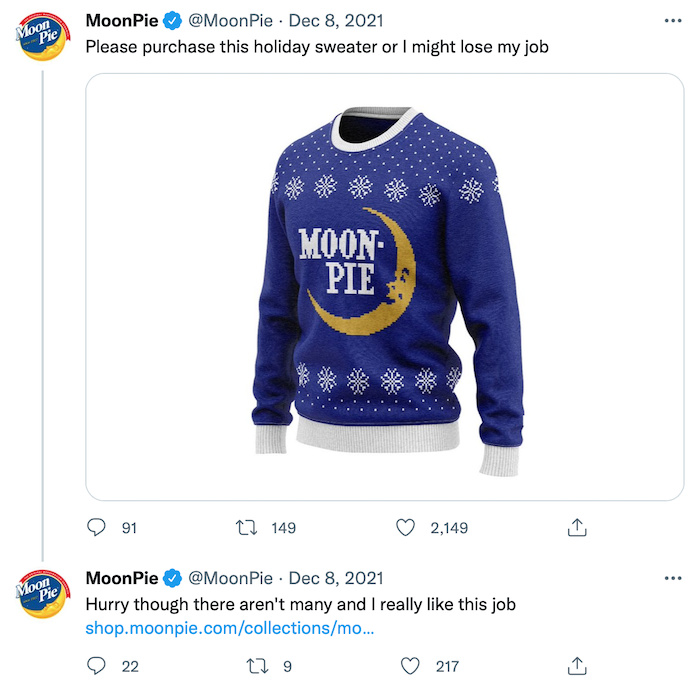
Here’s another example. Rather than just posting a product link, the social media manager appeals to followers with a quirky tone:
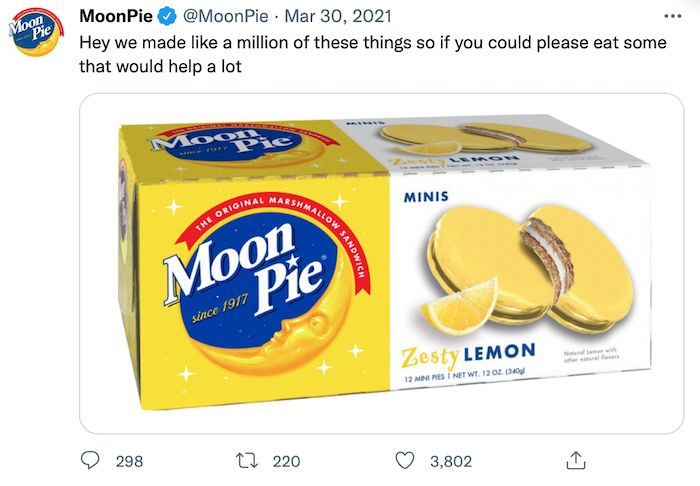
What’s the lesson here? Refine your brand voice. Here’s how.
- Revisit your company’s mission. Your voice should align with your company’s values, so make sure you’re clear on what your business stands for.
- Research your target demographic. What is your audience looking for? What do they care about? Use your answers to refine your voice.
- Take a look at your most successful content. Figure out what works and replicate this. For example, if your most successful content focuses on, say, your company’s eco-friendliness, create more content emphasizing this value.
2. Gymshark: Video Ad Campaign
Another way to stand out from your competitors is by making video content: 81 percent of marketers believe videos help them increase sales. Let’s break down a great content marketing example from Gymshark.
Gymshark wanted to promote a key message: fitness unites everyone. To do so, they ran the “United We Sweat” campaign, promoting inclusivity, diversity, and overcoming obstacles. They also designed promotional images to accompany the campaign:

The content works because it showcases the brand’s core message: uniting people through fitness. The slogan “United We Sweat” is simple and memorable, too, which helps.
How do you learn from this example? First, think about what makes your brand special. Revisit your mission statement and target market if you need a refresher.
Then, consider your campaign goals. Gymshark wanted to move away from its association with super-fit athletes and instead show why it’s a universal fitness brand. Placing “united” and “sweat” together makes sense.
Finally, keep it simple. When it comes to slogans and taglines, less is usually more.
Need some more inspiration? I walk you through how to write business slogans elsewhere.
3. Nadaré Co: Viral Content
Viral content instantly boosts your visibility, spreads your brand message, and generates more traffic, so it’s a worthwhile goal.
Let me use content marketing examples from Nadaré Co, a jewelry company, as an example of a successful content marketing strategy in action.
Nadaré Co’s founder began posting TikTok marketing content to promote the brand’s unique waterproof jewelry. She now has over 91,000 followers, over 1.3 million TikTok “likes,” and videos watched by thousands of people daily!
The secret to achieving this example of a content marketing strategy?
Post useful, highly targeted videos designed to entertain viewers, answer questions, and solve problems. For example, here’s a video on how to find your ring size, so customers know exactly which ring size will fit them before they order:
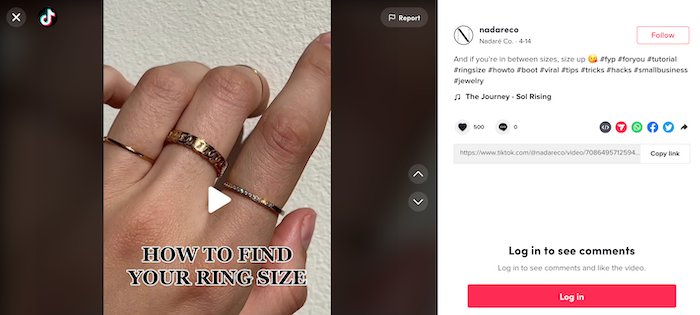
There’s also a video advertising the jewelry’s waterproof features and worldwide shipping:
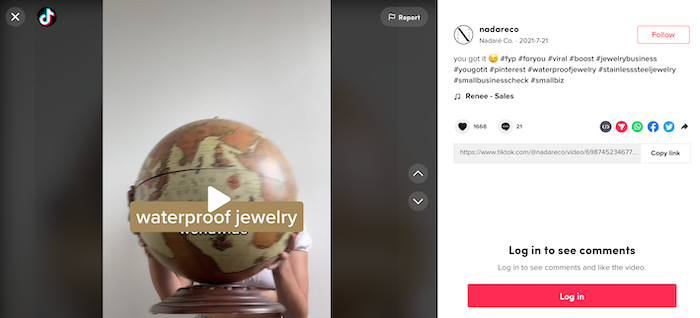
Here’s what we can take away from this content marketing strategy example.
- Keep your videos short and engaging.
- Highlight what makes your brand special in every video.
- Use relevant hashtags to improve your content’s visibility and reach.
4. Ridester: Long-form Content
To educate your audience, you need long-form posts in your content marketing strategy.
Research shows that in-depth posts typically outrank shorter, less comprehensive blogs, and the average first-page search result on Google has over 1,400 words.
In other words, long-form content is worth your time and Ridester has some great content marketing examples.
After losing a significant amount of traffic, Ridester prioritized writing long-form content to answer the questions readers care about.
In one blog post, for example, Ridester sets out actionable steps for making more money as an Uber Eats driver. There’s no fluff; it’s comprehensive but concise:
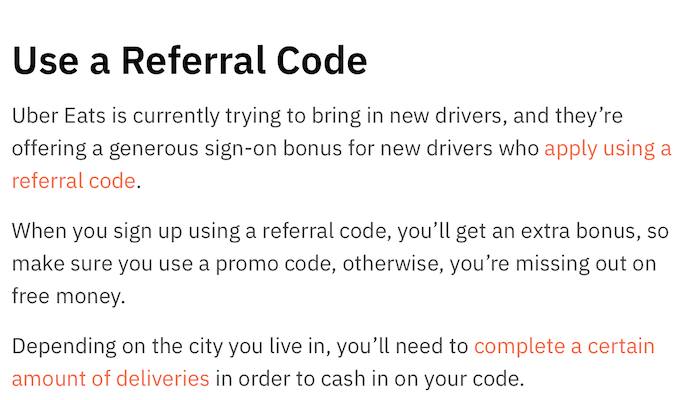
After revamping its long-form content, Ridester saw a 487 percent organic traffic increase and improved its search rankings for 16 search phrases. Cool, right? Here’s how you can emulate this success.
- First, use search tools like Quora and Reddit to discover what matters to your audience and what questions they’re asking.
- Next, try out Ubersuggest to find the right keywords to target in your content.
- Do some competitor research. Where are the content gaps? What questions have they failed to answer? Use the answers to these questions to complete your research.
5. Cricut: Influencer Marketing
Depending on your audience, influencer marketing is a highly effective strategy. Cricut, a DIY crafts supplier, illustrates why.
Cricut teamed up with “New Girl” actress Zooey Deschanel to promote its products. Deschanel, a real-life crafts enthusiast, brings authenticity and fun to Cricut’s content:
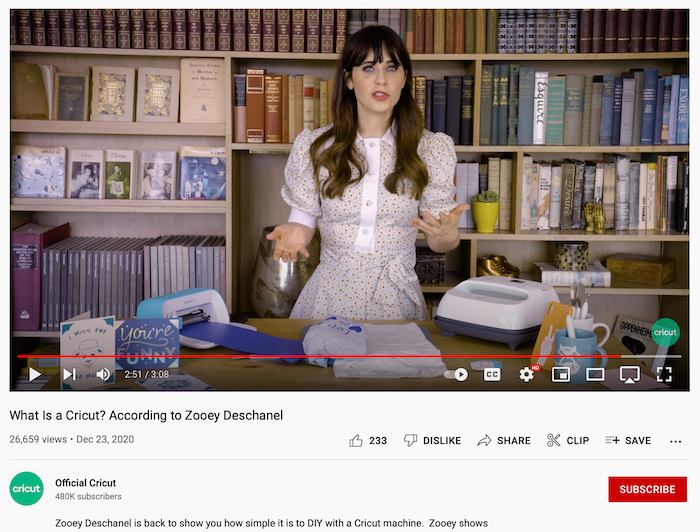
As we saw with Nadaré Co, videos are a great way to bring your product to life and build audience trust in your brand. Now, here are some tips for using influencers effectively in any content marketing strategy.
- Define what you need help with and determine how an influencer can help you achieve it.
- Make sure your influencer aligns with your brand. For example, Deschanel works great for Cricut because she’s a real-life crafts enthusiast.
- To maximize engagement, choose campaign-specific hashtags for the influencer to use to promote your products.
You can find influencers through social media keyword searches and influencer marketplaces.
6. Storiarts: User-generated Content
User-generated content (UGC) is proof your products work. You’re not paying a marketing team to write ads or promote an item. Instead, you’re letting your products speak for themselves through satisfied customers. That’s why consumers are 2.4 times more likely to say UGC is more authentic than branded content.
Storiarts does this well. Storiarts turned to Instagram with two goals in mind:
- Driving sales of its literary-themed products.
- Highlighting the brand’s commitment to ending illiteracy.
Users can post pictures of themselves enjoying Storiarts products on a dedicated hashtag, #committolit:

How did this campaign work out for Storiarts?
They’ve grown from an obscure Etsy store, into a recognizable brand with over 82,000 followers and counting.
Want to best take advantage of UGC? Here’s how.
- Create a dedicated hashtag on social media. Keep it short and memorable.
- Engage with customers who post on the hashtag to encourage participation.
- Choose a campaign that promotes your brand’s mission to boost your company’s profile.
Got a goal like ending illiteracy? Tell the world about it!
7. Fire & Ice: Product Videos
Want to showcase what’s so great about your products? Successful content marketing examples often come down to high-quality product videos.
When you create videos as a content marketing strategy, you aren’t alone. In fact, 69 percent of marketers increased their video budget for 2022 per the results of a recent Content Marketing Institute survey.
Videos show your products in action and, ideally, they should answer questions your target audience might have about your services.
Fire & Ice made a video explaining how their air conditioner repair service works.
In just a few minutes, the video sets out what customers can expect from their service and how much it costs. Most importantly, it includes a clear CTA (how customers can book an appointment.)
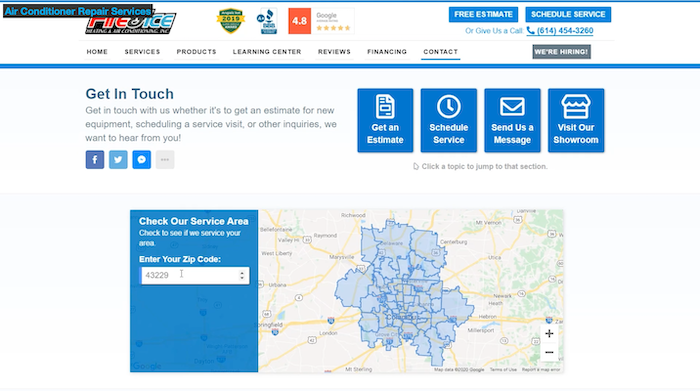
Here are some actionable takeaways from this example of a content marketing strategy:
- Do some market research to learn what your customers want.
- Consider repurposing existing content into video form.
- Break your videos into sections so viewers can jump to the most relevant part for their query.
- Always end with a clear CTA and include your contact details somewhere obvious.
8. Vienna Beef: Web Content
For our last content marketing strategy example, we’re talking about first impressions.
Why? Because first impressions matter.
In fact, 94 percent of consumers decide whether to browse a website based on its look and feel. In other words, when prospects land on your website, you want to set the right impression.
Vienna Beef, a Chicago-style hot dog manufacturer, knows this. After partnering with a digital marketing agency for a website redesign, they:
- tripled their website traffic
- reduced shopping cart abandonments
- increased sales
Here’s the homepage. It’s optimized for sales without being pushy. It’s also vibrant and engaging, with clear links to product pages:
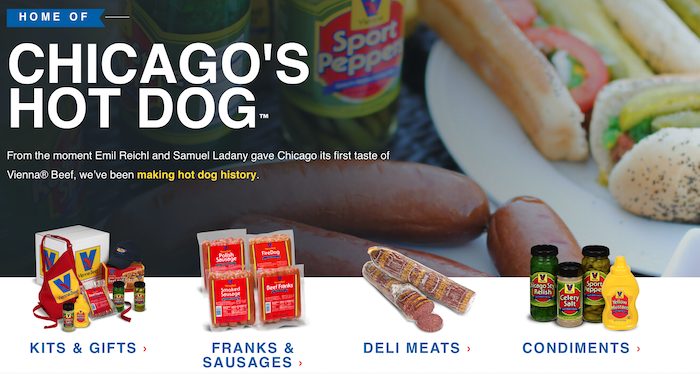
Scroll down and you’ll find links to hot dog stands and local stockists:

It’s easy to overlook website design when you think of content marketing, but actually, web copy and design are among your most important content.
My suggestion? Set clear goals. Vienna Beef knew exactly what they wanted from their redesign which is how they achieved it so successfully.
Then, hire a website designer. Effective website design is an art, and if you’re serious about content marketing and conversion, it’s worth the investment.
Finally, run some A/B testing to check which design elements work best. You might find my A/B testing guide helpful.
Content Marketing Examples: Frequently Asked Questions
What is content marketing?
Content marketing involves creating useful and engaging content across all mediums to organically grow your business, boost your visibility, and increase sales.
How can you recognize a good example of content marketing?
Whether it’s an informative blog post or an eye-catching graphic, all good content serves a purpose. It tells a story and reinforces a company’s brand identity. Great content marketing allows a brand to connect with its audience, so look for authenticity, professionalism, and strong messaging with a clear CTA or desired result.
How can you recognize an example of poor content marketing?
Again, it’s fairly easy to spot. Simply look for muddled messaging, unnatural or “keyword stuffed” writing, and content that lacks any clear CTA or purpose. Poorly-timed marketing campaigns which are insensitive to current news always fall short, too.
How can I best learn from examples of content marketing strategies I come across?
Be intuitive. Explore what you think works (or doesn’t work) and why. If you’re impressed by a content marketing example, consider how you can apply the principles such as engaging visual elements and strong brand messaging to your marketing efforts.
{
“@context”: “https://schema.org”,
“@type”: “FAQPage”,
“mainEntity”: [
{
“@type”: “Question”,
“name”: “What is content marketing?”,
“acceptedAnswer”: {
“@type”: “Answer”,
“text”: ”
Content marketing involves creating useful and engaging content across all mediums to organically grow your business, boost your visibility, and increase sales.
”
}
}
, {
“@type”: “Question”,
“name”: “How can you recognize a good example of content marketing?”,
“acceptedAnswer”: {
“@type”: “Answer”,
“text”: ”
Whether it’s an informative blog post or an eye-catching graphic, all good content serves a purpose. It tells a story and reinforces a company’s brand identity. Great content marketing allows a brand to connect with its audience, so look for authenticity, professionalism, and strong messaging with a clear CTA or desired result.
”
}
}
, {
“@type”: “Question”,
“name”: “How can you recognize an example of poor content marketing?”,
“acceptedAnswer”: {
“@type”: “Answer”,
“text”: ”
Again, it’s fairly easy to spot. Simply look for muddled messaging, unnatural or “keyword stuffed” writing, and content that lacks any clear CTA or purpose. Poorly-timed marketing campaigns which are insensitive to current news always fall short, too.
”
}
}
, {
“@type”: “Question”,
“name”: “How can I best learn from examples of content marketing strategies I come across?”,
“acceptedAnswer”: {
“@type”: “Answer”,
“text”: ”
Be intuitive. Explore what you think works (or doesn’t work) and why. If you’re impressed by a content marketing example, consider how you can apply the principles such as engaging visual elements and strong brand messaging to your marketing efforts.
”
}
}
]
}
Conclusion: Content Marketing Examples
If you’re serious about growing your business and getting some brand exposure, then you need a content marketing strategy.
Research successful examples, take what works, and identify how you can implement those techniques in your content.
Don’t forget to track your key metrics, too, so you can see what’s working…and fix what’s not.
Struggling to produce the right content for your goals? Check out my consulting services and discover how I can steer you in the right direction.
Have you found any other great content marketing examples? What did you learn from them?
Happiness Is a Warm Company?
Human well-being is neither a skill nor a virtue, and no business-school course can teach it.
The post Happiness Is a Warm Company? appeared first on #1 SEO FOR SMALL BUSINESSES.
The post Happiness Is a Warm Company? appeared first on Buy It At A Bargain – Deals And Reviews.
Top Options for $20k Loans If Your Company Has Been In Business for 3 Years or More
When we talk about building business credit and fundability, we do so with an end in mind. If you start working the process from the beginning, by the time you have been in business for 3 years or more you will have access to all the business funding you’ll need. That includes $20k loans or even higher.
Options for $20k Loans
If you follow the steps in order and handle credit responsibly, by the time you have reached this point you will be eligible for the best rates and terms available.
What are these options available to companies that have been in business for 3 years or more?
Term Loans
Banks are often the first place we think of when we consider financing. Yet, big banks only sign off on about 25% of the small business loan applications that come their way. Term loans often have lower interest rates than many other funding options. They also tend to be for higher loan amounts.
Generally speaking, the companies banks end up funding have:
- Very strong financials and
- Near-perfect credit scores
- Owners with good personal credit
- Collateral
You are more likely to meet these qualifications if you have at least 3 years in business and have been working on fundability and building business credit during that time.
Bridge Loans
A bridge loan is a short-term loan that a business or individual can use until they secure more permanent financing or remove an existing obligation. It allows the user to meet current obligations by providing immediate cash flow. Bridge loans are short term, up to one year. They have relatively high interest rates. Collateral such as equipment or inventory is common as well.
SBA Loans
Three years or more time in business will help make SBA loans a real possibility. It’ll be easier to get an SBA loan the longer you’re in business. This is because you can more easily show your business is established and making money consistently.
If you can show profitability and responsible credit and bank account management, your chances of getting an approval for an SBA loan will improve drastically.
SBA loans have great terms, so it’s worth it to work toward building eligibility.
SBA 504
The SBA 504 loan program is an economic development loan program that offers small businesses an avenue for business financing, while promoting business growth, and job creation.
This program provides approved small businesses with long-term, fixed-rate financing used to acquire fixed assets for expansion or modernization. Use it to buy currently existing buildings, construct new buildings, and more.
For corporations, anyone with a 20% ownership stake (or more) must fill out the application. This includes swearing they are not under indictment for any criminal offense. In general, the SBA provides 40% of the total project costs, a participating lender covers up to 50% of the total project costs and the borrower contributes 10% of the project costs.
Under certain circumstances, a borrower may have to contribute up to 20% of the total project costs.
SBA 7(a)
This is the SBA’s most popular loan. The SBA guarantees 85% for loans up to $150,000 and 75% for loans greater than $150,000. The SBA makes the lending decision, but qualified lenders may be given authority to make credit decisions without SBA review.
Businesses must provide Articles of Organization, business licenses, documentation of lawsuits, judgments, bankruptcy, or other pertinent documentation. Also, lenders do not have to take collateral for loans up to $25,000.
For loans in excess of $350,000, the SBA requires that the lender collateralize the loan to the maximum extent possible up to the loan amount.
Online Lending
Online lending works well for those with less time in business, or in situations where traditional lenders will not work. Still, they will offer better terms and rates to those companies in business longer and with strong fundability. That means, it is best to not discount them even after you reach this point.
Some of our favorite online lenders are listed here.
After 3 Years in Business, $20k Loans May Not Be An Issue
If you are here looking for options for $20k loans for your business, and you have been in business for 3 years or more, you are probably going to be okay. This is especially true if you have been working to build strong fundability and business credit as part of that.
If you are struggling to find $20k loans, start now building fundability, including strong business credit, and you’ll get there in no time.
The post Top Options for $20k Loans If Your Company Has Been In Business for 3 Years or More appeared first on Credit Suite.
It’s Like Free Money When You Stop Wasting Company Cash
How to Stop Wasting Company Funds – It’s Like Free Money Is it really free money? It may not be as glamorous as winning the lottery or venture capital money. It’s not as sexy as your content going viral. And it’s not as exciting as getting a shout out from major market influencers like Oprah … Continue reading It’s Like Free Money When You Stop Wasting Company Cash
It’s Like Free Money When You Stop Wasting Company Cash
How to Stop Wasting Company Funds – It’s Like Free Money
Is it really free money? It may not be as glamorous as winning the lottery or venture capital money. It’s not as sexy as your content going viral. And it’s not as exciting as getting a shout out from major market influencers like Oprah Winfrey and Elon Musk.
But it is often easy, and it is certainly anything that any company can do. It’s the free money you can get from cutting waste.
A Penny Saved is a Penny You Don’t Need to Borrow or Raise
Is your business wasting money? It probably is, in some way or another. Cutting waste should always be on your radar.
What are the Ripple Effects of Cutting Waste?
Save a dollar and you won’t need to:
- Borrow a dollar and pay it back with interest
- Try to raise a dollar via crowdfunding
- Sell a dollar’s worth of your business to an angel investor or venture capitalist
- Waste time you could be using to sell your goods or services
Get Free Money from Cutting Expenses
When tightening your company’s belt, look at the expenses going out first. There are several kinds of expenses any business can and should cut. Be creative when looking to cut expenses. Here are some kinds of expenses that you might not have thought of.
How to Save Money on Salaries
Employee salaries are the largest expense for many organizations. But did you know that there’s free money lurking in there?
But let’s make one thing perfectly clear. Don’t ask your employees to take a pay cut. Please, never do this! You’ll kill morale. But you should work to tap your employees’ full potential. Hence, pay attention to training.
Employees with more training may not be using that training. So, why aren’t they? Ask employees about their background and interests. There’s a chance that they could do more for you and get more motivated about working with your company in the long run. See inc.com/peter-cohan/first-90-days-13-totally-useless-expenses-your-company-is-wasting-money-on.html.
Stop Outsourcing!
Outsourcing is expensive! Some small businesses pay thousands of dollars to outsource projects. But your company may be able to save a considerable amount of cash, by taking some or all of those projects in-house.
Give your outsourced work to part- or full-time employees. After all, outsourcing work can make it hard to communicate clearly what you want done. This results in costly errors and delays. It is worth analyzing whether hiring a dedicated worker could pay for him or herself within a year.
Save Money with Better Hiring
Hiring the wrong person can be a very expensive proposition. Still, you need someone to do the work, and you don’t have forever to decide on who to hire. So make your job postings clear and only hire people experienced in what you need for them to do.
How can you hire better? Hire employees on a trial basis. This may be through working with a freelancing site like UpWork, or it may mean using a temp agency. In either of these scenarios if you must fail, at least you fail fast.
Demolish your funding problems with 27 killer ways to get cash for your business.
Start Improving the Average Performance of Your Workforce
Let the poor performers go. People who aren’t doing well tend to be unhappy anyway. You may be giving them the nudge they need to get something else. And make sure that all the workers staying on your payroll who do contribute are doing far more than the minimum required. If you can’t motivate your C players to act more like the superstars, cutting them from the payroll will give you the money you need to hire more A players.
Save Money on Tools
Software and tools can account for a huge proportion of a company’s expenses. But far too many businesses either buy tools they don’t need or buy tools that are bloated with features they don’t use. This can be software but also, literally, tools.
The truth is the so-called best tool on the market is often designed with large enterprises in mind. This means that when you’re small, it’s likely overkill. So it’s often better to purchase something that’s better suited to a business of your size. It may be a little less sexy, but it will save you a fair amount of money while still being equally as effective. See embroker.com/blog/business-expenses-startups-waste.
Location, Location, Location
Do you really need all that office space? Can employees share desks and work from home some of the time? Can some employees work from home all of the time? WFH also opens up hiring to other parts of the globe, where potential hires might be okay with less money.
Okay, so maybe you do need office space. But does it have to be in the most expensive part of town? Pay attention to the end date of your lease and start looking for cheaper digs before you’re under the gun.
And if you find less expensive office space elsewhere, tell your current landlord when it’s time to renew. If your business has been a good tenant, they might work to keep you.
Demolish your funding problems with 27 killer ways to get cash for your business.
Office Issues
Do you cater all your meetings? Do you really have to? If you must offer refreshments, why not handle some of them in-house? This doesn’t mean your employees start cooking. But it can mean a better coffee maker or better coffee to brew in it.
Energy Efficiency FTW
Do you have to pay utilities? Can you choose your own appliances? An energy efficient refrigerator will make a difference. So will using energy efficient fluorescent lighting. And just like in your house, turn off the lights when leaving a room.
Can You Imagine How Postage is Costing You Free Money?
Do you use a postage meter? It might not seem like a lot, but paying the exact amount for postage, rather than 5 cents more every time, will add up in the long run.
Would You Like to Save on Business Travel?
We all know about meetings that should have been emails. But they’re not so bad if your meeting is held remotely or just down the hall. Do you really have to be in the southern office? Particularly in the age of Covid-19, less travel is safer anyway.
Business Expenses
Does your business have a documented expense policy? Or can anyone claim pretty much anything at any time? Traveling employees might help themselves to the minibar or rent movies from the front desk, but your business doesn’t have to pay for such things.
Why and What Wasteful Advertising and Marketing is Costing You
Marketing can be trying new ideas to see if they work. That’s okay. But if you already know, then you should stop experimenting so much!
Like the best goals, your marketing and advertising have got to be measurable. Measuring helps you realize a lot more quickly if a campaign is working, or not. See nav.com/blog/4-money-leaks-that-could-be-hurting-your-bottom-line-658859.
Revealed… Saving on Miscellaneous Expenses
When you go grocery shopping, there are always small things at the checkout. They’re often inexpensive. So people buy them on impulse, even if they weren’t on the shopping list. But those packs of gum can add up over time.
In the same way, your little expenses here and there can add up. They can really get away from you if you just open up a petty cash drawer to buy them. So keep track of these expenses and review them every month or so. Determine if they’re working for you.
Demolish your funding problems with 27 killer ways to get cash for your business.
End Poor Time Management and Get Free Money
How long are your meetings? Are they all necessary? Really? A chat program like Slack might make some of those meetings unnecessary, or at least shorter.
Poor Time Management and Commuting
Commuting can also be exceptionally time-consuming. It can also be tiring, making it harder for employees to get going in the morning. Can some or even all of your employees work from home at least one day per week? This is also a way to enhance employee morale.
Free Money, Fixing Poor Time Management, and Enhancing Employee Morale – Yes, There’s a Connection
Consider informally monitoring the weather and telling your employees to work from home when commuting conditions will be truly awful. These are serious snowfalls or blizzards, or heavy rain from the remnants of hurricanes, not brief showers. Not only are commutes longer and more dangerous, but employees are also more likely to be late.
Get Some Free Money with a Proper Financial Professional
A solid accountant will help prevent costly errors. They will also be able to calculate and pay your business taxes correctly the first time. If you, the owner, are still preparing these documents, it’s probably not a good use of your time. If you currently can’t afford an accountant, at least get good professional accounting software.
Check Your Larger Bills Carefully
If you’re just getting a one-page bill from an outside counsel law firm, or other expensive service your business must have, ask for it to be itemized. Sometimes there are billing errors and this can be the only time they’re caught.
Get Free Money from No Longer Wasting It: Takeaways
Is your business wasting money? Stop the bleeding and hire more carefully. Look into your expenses more closely. Measure your advertising to see if it’s working. Keep an eye on ways to save time. A professional accountant is worth the expense. Audit the larger bills your business has to pay, and request itemization, to be sure you’re only being charged for what you actually owe.
The post It’s Like Free Money When You Stop Wasting Company Cash appeared first on Credit Suite.
Community Phone Company (YC W19) Is Hiring
Article URL: https://www.ycombinator.com/companies/community-phone-company/jobs/ENwCu0g-fullstack-engineer
Comments URL: https://news.ycombinator.com/item?id=27132511
Points: 1
# Comments: 0
How to Lower Your Company COGS
Increasing sales isn’t necessarily the best way to improve your bottom line. A better solution may be to reduce your Cost of Goods Sold.
Paying less to acquire the products you sell can result in higher gross revenue figures and bigger profits, even when the amount of product you sell stays the same.
If you’re ready to make more money without selling more products, here’s a recap of COGS and specific strategies to lower expenses.
A Quick Recap of Cost of Goods Sold (COGS)
What Is Cost of Goods Sold?
The Cost of Goods Sold (COGS) is all the costs of producing and acquiring the products you sell. You can separate COGS into two parts: direct costs and indirect costs.
Direct costs are the expenses incurred when producing the products you sell. They include:
- raw material costs
- labor costs during production
- other production overheads
- the cost of wholesale products
Indirect costs are all the other expenses incurred when you manufacture products that aren’t tied directly to the process. They include:
- storage
- shipping
- labor
- custom duties
- software
- packaging costs
It’s also worth clarifying what COGS is not.
Your COGS is not the same as your operating expenses, for example. Both are expenditures, but operating expenses (also known as OPEX) are not tied to your products’ production. Instead, they include costs like rent, utilities, marketing, and legal.
They also aren’t the cost of sales either, as this infographic from EDUCBA shows.

How Do I Calculate Cost of Goods Sold?
Businesses can calculate COGS using a standard formula that considers inventory levels and all of the direct and indirect costs listed above.
COGS = Opening Inventory + Purchases During a Period – Closing Inventory
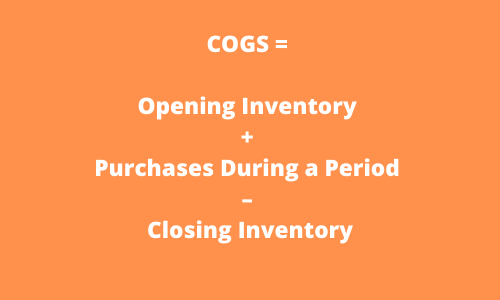
- Opening Inventory is the value of inventory you hold at the start of a given period (like a financial year.)
- Product purchases and all resulting costs (as listed above) are added to the opening inventory.
- Closing inventory (the value of products that aren’t sold at the end of the period) is subtracted from that total to calculate the final Cost of Goods Sold.
Here’s an example:
Let’s say we want to calculate an e-commerce brand’s COGS during the 2019 financial year. The opening inventory would be the inventory recorded at the end of the 2018 fiscal year. Let’s say it’s $2 million.
The closing inventory would be the inventory recorded on the company’s balance sheet at the end of the 2019 fiscal year. Let’s say that is $3 million. Finally, the company purchased $5 million worth of inventory during the 2019 fiscal year.
The COGS for the 2019 financial year is:
2 + 5 – 3 = $4 million
The COGS is $4 million.
If you want to see what calculating COGS looks like in the real world, Investopedia provides an example using J.C. Penney’s 2016 financial report.
The calculation can also change depending on how you define closing inventory. There are three options:
- FIFO (first in, first out): The first item you add to your inventory is the first item that gets sold. This option will minimize the COGS as long as the price continues to rise.
- LIFO (last in, first out): The last item you add to your inventory is the first item that gets sold. If prices are rising, this will maximize the COGS and reduce profit.
- Averaged costs: Costs are taken as an average, offering a balance between FIFO and LIFO.
Why Should I Think About COGS?
COGS is a crucial line on your balance sheet. By paying attention to it, you can:
- Improve profit margins. Understanding how much you spend on products can help you reduce your e-commerce overhead.
- Identify profitable products. Calculating your COGS will help you determine which products are most profitable and which aren’t.
- Price accurately. Knowing your COGS will help you price your products. When you know the cost of every product you sell, you can make sure you’re pricing in a healthy margin.
- Get taxed appropriately. COGS is a business expense that is deducted from your total revenue. In other words, you won’t be taxed on it because they are business expenses. This might be the only reason you’d consider a higher COGS to be a good thing. Remember, however, that higher COGS means less revenue and, therefore, less profit.
7 Tips to Reduce COGS
Now that you’re up to speed, it’s time to get to the heart of the matter and look at how you can reduce your company’s COGS.
I’ve outlined seven strategies below that almost any business can leverage.
1. Stop Making Products That Don’t Sell
Do you have a large amount of deadstock sitting in your warehouse? These are products that haven’t been sold and are unlikely to sell in the future. If so, they could be killing your margins and contributing massively to your COGS. Remember, the COGS calculation takes into account the inventory you have at the start and end of your accounting period. It doesn’t matter how long it’s been sitting there: it’s going to be in the calculation.
Deadstock isn’t great, but there’s an easy way to make sure it doesn’t increase your COGS going forward: Stop making products that don’t sell.
Of course, no business owner starts out intending to make a product consumers hate, but it happens. Even the biggest businesses have flops now and again. New Coke, anyone? I didn’t think so.
Don’t worry about creating the wrong products, only worry about identifying ones that aren’t selling well. Use inventory management software to identify products languishing at the back of your warehouse.
Encourage customers to review your products to drive real-time feedback from the people that matter most. Then act quickly. As soon as you identify an under-performing product, take steps to decrease production or cease selling it altogether.
2. Find Lower Cost Materials
Material costs are probably one of the largest components of your COGS. Typically, there’s no shortage of material suppliers, which means you may be able to find cheaper products somewhere else.
Shopping around for materials from different suppliers is one solution, but you could also consider whether a part of your finished product could be replaced with a cheaper alternative. You may think that your customers love the sturdy metal used in your product, for example, but they could be just as happy with a plastic substitute.
It may also be worth revisiting technology used in production to identify whether new processes mean cheaper materials can be used.
Whichever strategy you use, be careful of using cheaper materials at the expense of your end product. Providing a consistent experience is one of the best ways to build trust in your brand, and customers expect to receive the same product every time.
Even loyal customers can quickly switch to competitors if your products are not up to their expectations. A drop in sales can be far more significant than any savings you’ve gained by switching materials.
That’s not the only downside you need to consider, however. Inferior materials can also reduce the durability of your product. Changing materials may necessitate a change in the manufacturing process. This could increase production overheads or labor costs to such an extent that they nullify any costs saved.
3. Eliminate Costly Waste
There’s bound to be waste somewhere in your supply chain. Your manufacturing process may be inefficient, for example, and waste a lot of raw materials. You may even need to pay to dispose of them. Shrinkage may also be significant. This is when products are damaged, stolen, or go missing.
Waste doesn’t have to be physical. There could be plenty of time wasted in the manufacturing or shipping process that could be reduced to improve your COGS. Downtime can be expensive, whether that’s on the factory floor or when products are at sea.
Investigate all instances of waste in your supply chain, physical or otherwise, and take actions to reduce or eliminate the most expensive culprits.
One strategy could be to redesign the manufacturing process if material waste is significant. Another could be to alter transport arrangements if shrinkage is high and many products are arriving damaged.
4. Automate Parts of Your Business
Labor can be a significant part of your COGS. Luckily, you may be able to automate some of those expenses away. Every part of the manufacturing or shipping process that you can replace with a machine can save huge costs. Machines are typically cheaper to operate in the long run, there is less risk of error and have practically no downtime.
Once you’ve done your part, ask the same of your suppliers. Request they invest in automation to reduce costs if they haven’t already. You may even be able to use this as part of a negotiation strategy as discussed below. If they’re not willing to play ball, consider switching to another supplier investing in automation. If they aren’t cheaper right now, they could well be in the future.
5. Investigate Offshore Manufacturing
Manufacturing in the U.S. (or your country of origin) can often be a huge selling point. It can also be incredibly expensive. That’s why so many of the world’s biggest brands outsource manufacturing operations to countries like China, Taiwan, and Vietnam.
Both raw materials, labor, and utility costs are often much cheaper in these countries than they are at home, meaning your business stands to save in multiple ways. Even when you factor in increased shipping costs, your COGS could still plummet when you outsource manufacturing.
Only large enterprises should consider this strategy, however. The upfront costs can be substantial, and there are a lot of risks involved.
Quality problems may arise, for instance, and you may have to deal with PR issues as a result of labor conditions in these countries. Currency fluctuations and customs duties can complicate matters further.
For some businesses, however, the opportunity to drastically reduce their COGS will be well worth it.
6. Consider Manufacturing on Demand or Dropshipping
One of the biggest contributing factors to COGS is inventory purchases made throughout the year. The more products you buy, the more costs rise.
Rather than stock products that may not sell, brands could reduce their COGS by using a manufactured on-demand strategy. In essence, you only make or order products when a customer has already paid.
Print-on-demand sites like Printful and dropshipping are two of the most-common ways to leverage this strategy.
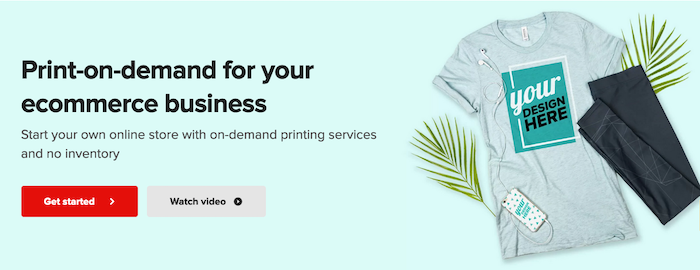
With Printful, products are printed in real-time as soon as an order is made. There’s not even a minimum order limit.
It’s the same with dropshipping. Businesses only pay for products when the customer pays for them. In both cases, items can be shipped directly to customers, meaning stores don’t need to hold any inventory.
7. Negotiate With Everyone
You can and should be regularly negotiating prices with every company in your supply chain. The prices you pay suppliers are a core part of your COGS. Reduce them, and your COGS will decrease, too.
When I say every company, I really do mean all of them. Manufacturers, raw material providers, logistics companies, storage facilities, and wholesalers are all able to give you a lower price if you ask.
Here are some deals you could ask for:
- lower per-unit prices
- bulk discounts
- lower prices in return for quicker payments
- lower prices in return for upfront payment
- lower minimum order requirements
Remember, negotiation is a two-way street. While some companies will be willing to lower prices just to keep your business, others will require something in return to sweeten the deal. Improving their payment terms, for instance, is always a useful bargaining chip.
It’s also important to remember your negotiations may have unintended consequences. Asking for bulk discounts will require you to store more products, for example, and come with a cost increase that may eclipse any savings you made. Asking for lower prices in return for faster payments may require you to improve your cash flow.
Think carefully about what you are asking for and make sure you can handle the consequences of your negotiations. The last thing you want to do is renege on a deal because you negotiated poorly.
Conclusion
Boosting your sales is essential, but so is reducing your company’s COGS. Whether it’s negotiating hard with suppliers, reducing waste, or automating your processes, look to reduce costs in every way possible.
I’ve given you seven strategies to get started with, but there are always more ways to reduce costs.
What innovative ways to reduce costs have you found?
Community Phone Company (YC W19) Is Hiring
Article URL: https://communityphone.org/pages/careers
Comments URL: https://news.ycombinator.com/item?id=25246326
Points: 1
# Comments: 0


